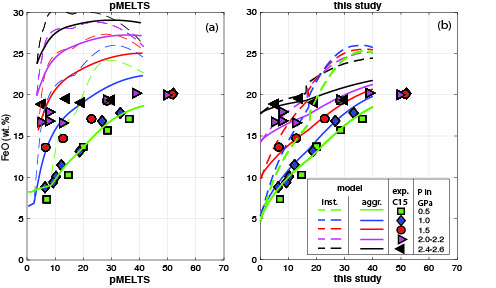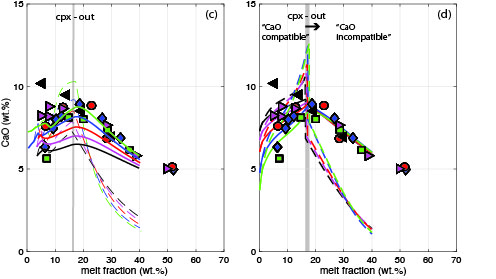An empirical melting model for the Martian mantle
- 1Institute of Planetary Research, German Aerospace Center (DLR), Berlin, Germany (max.collinet@dlr.de)
- 2Impact and Meteorite Research, Museum für Naturkunde Berlin, Berlin, Germany
The Martian crust has long been thought to be made of relatively uniform FeO-rich mafic rocks but, over the last two decades, new meteorite discoveries, orbital and in-situ analysis of Martian rocks have painted a more nuanced picture. Alkaline rocks, silica-rich rocks and possible anorthosites have been identified at several locations [e.g., 1]. The basaltic rocks, still believed to account for the majority of the upper crust, also display a chemical variability that could be tied to the thermal-evolution of the planet’s interior [2]. Those various lithologies indicate that Mars had a rich geologic history and that the crust was shaped by a wide range of igneous processes.
The abundant basalts likely result from decompression melting of the upper mantle and represent a “secondary” crust that would have covered any “primary” crust formed during the crystallization of the magma ocean. The compositions of the melts transferred from the mantle to the crust are controlled by the pressure and temperature of melting and are best constrained with experiments [3]. However, experiments represent snapshots at fixed P-T and usually simulate isobaric batch melting processes that are not completely analogous to actual melting conditions in the mantle. An alternative is to use thermodynamic models [4, 5], which can be used to simulate polybaric and fractional melting. Unfortunately, those models show several important shortcomings. For example, pMELTS [4] systematically overestimates the FeO content of the melts produced at high pressure. To simulate partial melting of the Martian mantle, other workers have adopted a hybrid approach using pMELTS and corrections based on experiments [1-2]. This type of hybrid approach is still problematic because the magnitude of the offsets relative to experiments are pressure-dependent and larger than previously anticipated (e.g., up to 8 wt.% (Fig. 1a) vs. 3 wt.% [1-2] for FeO).
Here, we present a simple empirical model that reproduces the composition of experimental melts more accurately (Fig. 1b, 1d) and can also be used to simulate various melting behaviors. It is similar in concept to melting models developed for the near-fractional polybaric melting of the Earth mantle at mid-oceanic ridges [6]. The concentrations of minor and major incompatible elements (TiO2, Al2O3, Na2O, K2O and P2O5) into the melt are first calculated from experimentally determined partition coefficients between minerals and melt [3]. The concentration of the other major elements (SiO2, FeO and MgO) are then deducted from the concentration of incompatible elements and pressure. CaO is treated as a major compatible element or as an incompatible element, based on whether clinopyroxene is present in the residue (Fig. 1d).
The new empirical model calculates the composition of “instantaneous melts” formed by isobaric or polybaric continuous melting with an adjustable critical melt fraction (i.e. melt fraction retained in the residue). Compared to batch and aggregate melts (symbols and solid lines in Fig. 1), instantaneous melts (dashed lines in Fig. 1) become enriched in FeO, MgO and CaO and depleted in incompatible elements (e.g., K2O, Na2O, Al2O3) as melting progresses. Instantaneous melts can be pooled and directly compared to the composition of the Martian crust. They could also be used as input for more advanced modelling of igneous differentiation (e.g. involving fractional crystallization, magma mixing, etc.) to account for the formation of the more evolved Martian igneous rocks. In a future step, the new model will be used to incorporate an accurate treatment of compositional changes due to melting and depletion of the mantle in global thermochemical evolution models.


Fig. 1. Composition of mantle melts from a primitive mantle composition [7] at different but constant pressure (isobaric melting). (a, c) pMELTS model. (b, d) Empirical model. In this example, both models simulate continuous melting (near-fractional melting) with a 1% retained melt fraction. The dashed lines represent the “instantaneous melts” constantly removed from the residue. The solid lines represent the total pooled or “aggregate melts”, the sum of all previous instantaneous melts. Under isobaric conditions, aggregate melts are analogous to batch melts. Symbols (exp. C15) represent batch melts from the experiments of [3]. pMELTS accurately reproduces the experimental melt compositions at 0.5 GPa but not at higher pressure.
References:
[1] Sautter et al. (2015) Nat. Geosci. 10.1038/ngeo2474, [2] Baratoux et al. (2011) Nature 10.1038/nature09903, [3] Collinet et al. (2015) EPSL 10.1016/j.epsl.2015.06.056, [4] Ghiorso et al. (2002) G3 10.1029/2001GC000217, [5] Holland et al. (2018) J. Petrol 10.1093/petrology/egy048, [6] Till et al. (2012) JGR 10.1029/2011JB009044, [7] Dreibus and Wänke (1985) Meteoritics
How to cite: Collinet, M., Plesa, A.-C., Ruedas, T., and Breuer, D.: An empirical melting model for the Martian mantle , Europlanet Science Congress 2020, online, 21 Sep–9 Oct 2020, EPSC2020-1019, https://doi.org/10.5194/epsc2020-1019, 2020.

